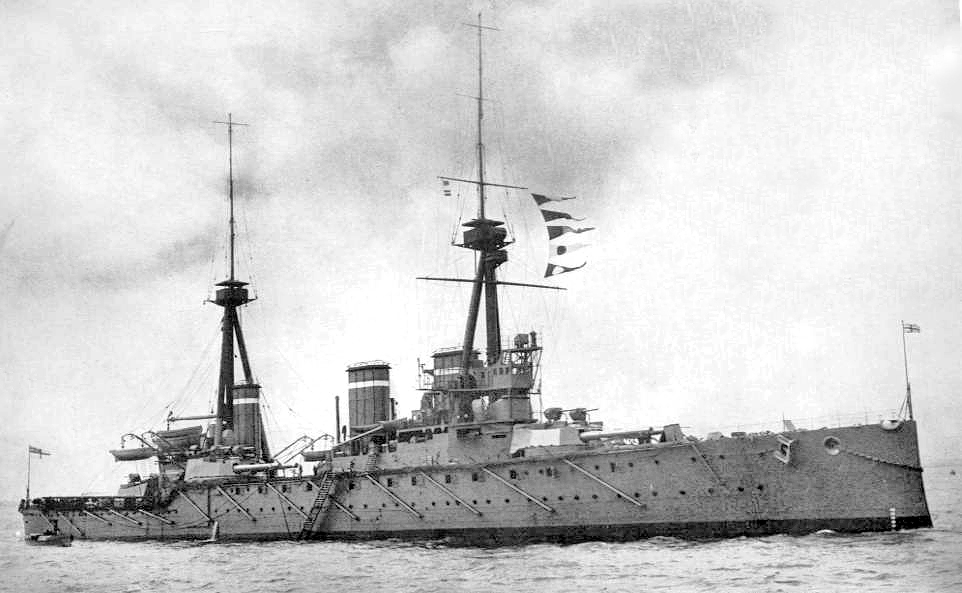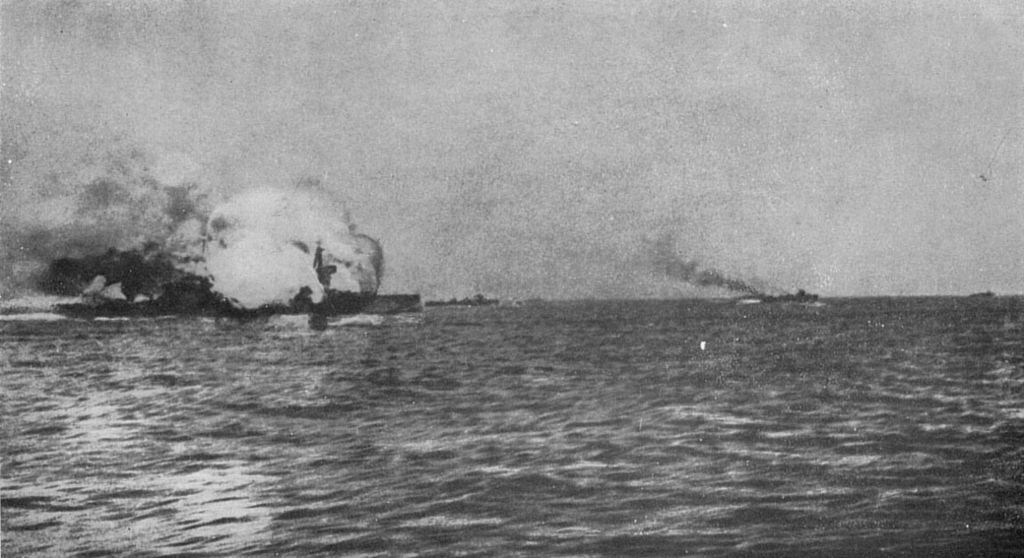by Susan Flantzer
- Rear Admiral The Honorable Sir Horace Hood
- Timeline: May 1, 1916 – May 31, 1916
- A Note About German Titles
- May 1916 – Royals/Nobles/Peers/Sons of Peers Who Died In Action
Rear Admiral The Honorable Sir Horace Hood
For two days, May 31 – June 1, 1916, the Battle of Jutland was fought in the North Sea near Denmark’s Jutland peninsula between the British Royal Navy’s Grand Fleet and the Imperial German Navy’s High Seas Fleet. A total of 250 ships were engaged in the battle, with fourteen British and eleven German ships sunk. 9,823 men were killed in the battle, 6,784 British and 3,039 German. One of those causalities was Rear Admiral The Honorable Sir Horace Hood who died when the HMS Invincible sunk during the Battle of Jutland in the North Sea with the loss of all but six men.
The Honorable Horace Lambert Alexander Hood was born in London, England on October 2, 1870, the fourth of the eight children of Francis Wheler Hood, 4th Viscount Hood of Whitley and Edith Lydia Drummond Ward. The peerage Viscount Hood was created for Horace’s great-great-grandfather Admiral Samuel Hood, who was known for his service in the Royal Navy during American Revolutionary War and French Revolutionary Wars, and for acting as a mentor to the naval hero Horatio Nelson.

Samuel Hood, 1st Viscount Hood; Credit – Wikipedia
Horace’s seven siblings:
- The Honorable Mabel Hood (1866 – 1904), married Francis Baring, 5th Baron Ashburton, had issue
- The Honorable Grosvenor Arthur Frederick Hood (1867 – 1868), died young
- Grosvenor Arthur Alexander Hood, 5th Viscount Hood of Whitley (1868 – 1933), married (1) Jane Stapleton-Cotton, no issue; (2) his first cousin Marguerite Hood, no issue
- Lieutenant Colonel The Honorable Neville Hood (1872 – 1948), married Eveline Broad, had issue
- The Honorable Alma Hood (1875 – 1877), died young
- The Honorable Dorothy Hood (1877 – 1965), unmarried
- Colonel The Honorable Francis Hood (1880 – 1949), married Helen Prior, had issue
Horace’s career in the Royal Navy began when he was only 12 years old as he started his cadet training on the HMS Britannia at Dartmouth, England. Three years later, he graduated at the top of his class and joined the HMS Temeraire as a midshipman. In 1890, Horace set a record score for his examinations for his promotion to lieutenant. He scored 4398 points out of a possible 4600 points. Horace saw service on the Nile in 1897-1898 and in Somaliland in 1903-1904.
Beginning in 1906, Horace spent time in Washington, DC as the naval attaché to the British Embassy. In 1910, he became Captain of the Royal Naval College at Osborne and two years later was made a naval aide-de-camp to King George V. Horace was promoted to Rear Admiral in 1913 and in June 1914 he became naval secretary to the First Lord of the Admiralty, Winston Churchill. After the onset of World War I, Horace took command of a small naval force assisting the British and Belgian armies in trying to prevent the German navy from advancing towards ports on the British Channel. In May 1915, he took command of the 3rd Battle Cruiser Squadron of the Grand Fleet aboard his flagship the HMS Invincible.
During his time in Washington, DC, Horace met an American widow with a young daughter, Ellen Touzalin Nickerson. On January 19, 1910, Horace and Ellen were married, and the couple had two sons. Upon the death of their father in 1907, Horace’s brother Grosvenor had succeeded their father as the 5th Viscount Hood. Grosvenor’s two marriages were childless, and Horace was the heir presumptive to the peerage until his death in 1916. After Horace’s death, his elder son Samuel was the heir presumptive to the peerage and succeeded his uncle as the 6th Viscount Hood in 1933. Samuel never married, so upon his death his brother Alexander became the 7th Viscount Hood. The current Viscount Hood, Henry Lyttelton Alexander Hood, 8th Viscount Hood of Whitley, is Horace’s grandson.
Children of Horace and Ellen:
- Samuel Hood, 6th Viscount Hood of Whitley (1910 – 1981), unmarried
- Alexander Lambert Hood, 7th Viscount Hood of Whitley (1914 – 1999), married Diana Maud Lyttelton, had issue including Henry Lyttelton Alexander Hood, 8th Viscount Hood of Whitley
Horace was knighted posthumously and Ellen was granted the style of a knight’s wife, Lady Hood, for the remainder of her life. She never remarried and died in 1950. Her daughter Katherine Nickerson from her first marriage married Walter Ernest Christopher James, 4th Baron Northbourne of Betteshanger .

Ellen Hood (née Touzalin) by Bassano Ltd, whole-plate glass negative, 16 February 1922 NPG x121328 © National Portrait Gallery, London
The Battle of Jutland was the largest naval battle during World War I. The British objective was to destroy the German High Seas Fleet or at the least, to keep the German force contained and away from British shipping lanes. Because the German Imperial Navy was insufficient to engage the entire British fleet, the German objective was to lure, trap and destroy a portion of the British Grand Fleet.

HMS Invincible; Photo Credit – Wikipedia
Rear Admiral Horace Hood was aboard the battlecruiser HMS Invincible, the first battlecruiser to be built by any country in the world, leading the three ships of the Third Battle Cruiser Squadron. During the battle, the HMS Invincible was hit in her “Q” turret by a round of fire from the German battlecruiser SMS Lützow, causing a massive explosion. The ship broke in two and sank in 90 seconds with the loss of all but six of the crew of 1,026, including Rear Admiral Horace Hood.

HMS Invincible exploding at Jutland, taken from a destroyer nearby; Photo Credit – Wikipedia

The two shattered halves of HMS Invincible temporarily standing on the seabed; Photo Credit – Wikipedia
The remains of the HMS Invincible and its crew are at the bottom of the North Sea, and the site is a protected war grave. Horace Hood’s name along with the names of members of the Royal Navy who died in World War I with no known grave are inscribed on the Portsmouth Naval Memorial. In 1918, Horace’s widow launched the battlecruiser HMS Hood, named after Horace’s great-great-grandfather Admiral Samuel Hood, 1st Viscount Hood. During World War II, the HMS Hood was sunk by the German battleship Bismarck. Of the 1415 aboard, only three survived.

Porstmouth Naval Memorial; Photo Credit – By Martyn Pattison, CC BY-SA 2.0, https://commons.wikimedia.org/w/index.php?curid=9130746
*********************************************************
Timeline: May 1, 1916 – May 31, 1916
May 7 – 10 – Battle of Kondoa Irangi in Kondoa Irangi, German East Africa (now in Tanzania)
May 10 – Germany suspends unrestricted submarine warfare
May 15 – June 10 – Battle of Asiago at the Asiago plateau in Veneto, Italy
May 16 – Signing of the Sykes-Picot Agreement between Britain and France defining their proposed spheres in the Middle East
May 31 – June 1 – Battle of Jutland between Britain’s Grand Fleet and Germany’s Hochseeflotte
*********************************************************
A Note About German Titles
Many German royals and nobles died in World War I. The German Empire consisted of 27 constituent states, most of them ruled by royal families. Scroll down to German Empire here to see what constituent states made up the German Empire. The constituent states retained their own governments, but had limited sovereignty. Some had their own armies, but the military forces of the smaller ones were put under Prussian control. In wartime, armies of all the constituent states would be controlled by the Prussian Army and the combined forces were known as the Imperial German Army. German titles may be used in Royals Who Died In Action below. Refer to Unofficial Royalty: Glossary of German Noble and Royal Titles.
24 British peers were also killed in World War I and they will be included in the list of those who died in action. In addition, more than 100 sons of peers also lost their lives, and those that can be verified will also be included.
*********************************************************
May 1916 – Royals/Nobles/Peers/Sons of Peers Who Died In Action
The list is in chronological order and does contain some who would be considered noble instead of royal. The links in the last bullet for each person is that person’s genealogical information from Leo’s Genealogics Website or to The Peerage website. If a person has a Wikipedia page, their name will be linked to that page.
Freiherr Karl von Moreau
- son of Freiherr Ferdinand von Moreau and Freiin Elisabeth von Eichthal
- born July 28, 1885 in Kleeburg, France
- married 1913 Freiin Eugenie von Loë, no issue
- killed in action on May 26, 1916 at Verdun, France, age 30
- brother-in-law of Freiherr Hubertus von Loë and Freiherr Klemens von Loë, who both were killed in action earlier in World War I
- http://www.genealogics.org/getperson.php?personID=I00110691&tree=LEO
Midshipman The Honorable Bernard Michael Bailey
- son of Joseph Russell Bailey 2nd Baron Glanusk and Editha Elma Sergison
- born January 17, 1899
- unmarried
- killed in action on May 31, 1916, age 17, when the HMS Defence sunk during the Battle of Jutland in the North Sea with the loss of all men on board
- http://www.thepeerage.com/p42120.htm#i421193
Lieutenant Commander The Honorable Hugh Cecil Robert Feilding
- son of Rudolph Feilding, 9th Earl of Denbigh and The Honorable Cecilia Mary Clifford
- born December 30, 1887
- killed in action on May 31, 1916, age 29, when the HMS Defence sunk during the Battle of Jutland in the North Sea with the loss of all men on board
- http://www.thepeerage.com/p7608.htm#i76076
Rear Admiral The Honorable Sir Horace Lambert Alexander Hood
- son of Francis Wheler Hood, 4th Viscount Hood and Edith Ward
- born October 2, 1870 in London, England
- married 1910 Ellen Touzalin Nickerson, had two sons who both succeeded to the title Viscount Hood
- killed in action on May 31, 1916, age 45, when the HMS Invincible sunk during the Battle of Jutland in the North Sea with the loss of all but six men
- http://www.genealogics.org/getperson.php?personID=I00273848&tree=LEO
Midshipman The Honorable Cecil Richard Molyneux
- son of Osbert Cecil Molyneux, 6th Earl of Sefton and Lady Helena Mary Bridgeman
- born December 2, 1899
- unmarried
- one of the 99 men killed in action on May 31, 1916 aboard the HMS Lion during the Battle of Jutland in the North Sea, age 16
- http://www.thepeerage.com/p7249.htm#i72484
Commander Henry Ernest Digby Hugh Willoughby
- eldest son of Godfrey Ernest Willoughby, 10th Baron Middleton of Middleton and Ida Eleonora Constance Ross
- born July 1, 1882
- unmarried
- killed in action on May 31, 1916, age 33, when the HMS Indefatigable sunk during the Battle of Jutland in the North Sea with the loss of all but two men
- http://www.thepeerage.com/p4652.htm#i46520
Commander The Honorable Lionel Henry Shore
- son of Henry Noel Shore, 5th Baron Teignmouth and Mary Aglionby Porteus
- born November 18, 1882
- killed in action on May 31, 1916, age 33, when the HMS Invincible sunk during the Battle of Jutland in the North Sea with the loss of all but six men

